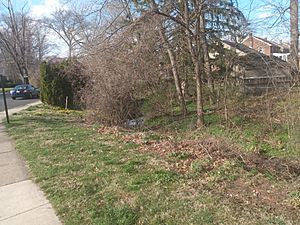Naylors Run facts for kids
Naylors Run is a stream about 4.6 miles (7.4 km) long. It flows into Cobbs Creek in Haverford and Upper Darby Township, Pennsylvania, United States. A stream that flows into a larger river or creek is called a tributary.
In 1975, a small dam was built near Naylors Run Park. This dam helps to control flooding in the area.
Part of Naylors Run flows underground in Upper Darby. It goes from Sherbrook Boulevard to Walnut Park Drive, where it joins Cobbs Creek. Many parts of Naylors Run were put into underground pipes called culverts. This was done to make space for buildings and homes above the ground. Naylors Run meets Cobbs Creek near 63rd Street and Cedar Lane.
Normally, Naylors Run might dry up sometimes, meaning it would be an intermittent stream. But now, it flows all the time, making it a perennial stream. This is because treated water from a special cleanup site is released into it.
Contents
Why Was Naylors Run Polluted?
Naylors Run was badly polluted by a place called the Havertown PCP Superfund site. From 1947 to 1991, a company named National Wood Preservers (NWP) treated wood there. They used chemicals to protect the wood.
During their work, these chemicals and waste were dumped into a well on the property. These harmful chemicals then flowed directly into Naylors Run.
Discovering the Pollution
In 1962, people living nearby complained about an oily substance in the stream. The Pennsylvania Department of Health investigated and found pollution leaking into Naylors Run. They figured out it was from NWP's waste.
Tests showed high levels of a chemical called pentachlorophenol (PCP) in the water. Even a small amount of PCP can be deadly for fish. The Environmental Protection Agency (EPA) later called this site one of the worst cleanup projects in the United States.
Early Cleanup Efforts
In 1976, the EPA started working to clean up the stream. They put in special filters to remove the oily PCP from the water. They also tried to seal pipes that were leaking chemicals. However, pollutants still kept flowing into Naylors Run.
From 1981 to 1983, the EPA studied how much the stream was polluted. They thought that most of the PCP had sunk into the mud at the bottom. This mud could then become a new source of pollution. The EPA suggested that NWP put up signs along Naylors Run. These signs warned people about the health risks.
Finding More Chemicals
In 1987, the EPA took more samples from Naylors Run. They found other harmful chemicals besides PCP. These included arsenic, benzo(a)anthracene, benzo(a)pyrene, and dioxin.
In 1989, the EPA installed a special system. It had a catch-basin and an oil/water separator for the storm drain. This helped to stop some chemicals from entering the stream. In 2001, this separator was removed after new recovery wells and a water treatment plant were built at the main pollution site.
Current Status of Naylors Run
By 2008, the EPA found that the mud and water in Naylors Run no longer had too many chemicals from the Havertown PCP Superfund site. However, they did find other chemicals from different sources that were still above safe levels.
Cleanup and monitoring efforts are still happening. In 2013, the EPA handed over control of the site to the Pennsylvania Department of Environmental Protection. In 2020, a report said the site was "short-term protective of human health and the environment." This means it was safe for people and the environment for now.


